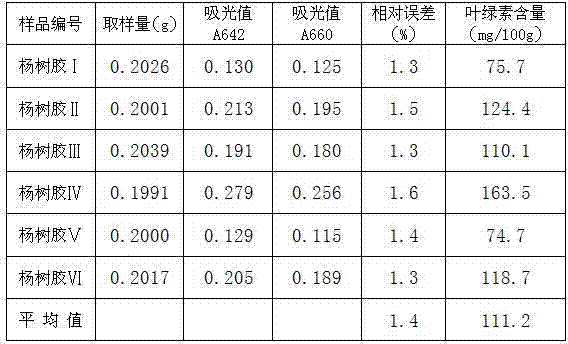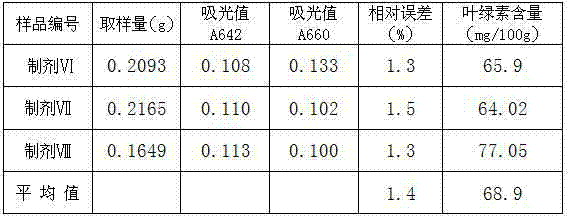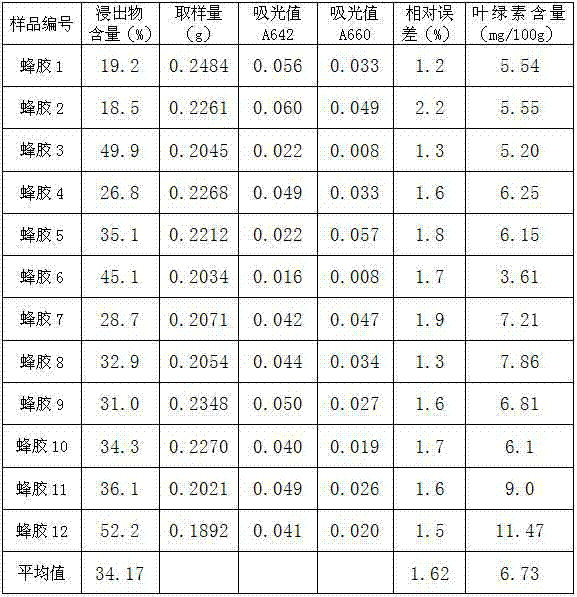Method for identifying propolis and poplar glue by detecting chlorophyll content
A technology for chlorophyll content and chlorophyll, which is applied in the preparation of test samples and the measurement of color/spectral properties, etc., can solve the problems of expensive instruments, inability to distinguish between propolis and poplar gum, and high price. The effect of easy-to-obtain samples and equipment, and simple detection methods
- Summary
- Abstract
- Description
- Claims
- Application Information
AI Technical Summary
Problems solved by technology
Method used
Image
Examples
Embodiment 1
[0025] Principle of the method: extract the chlorophyll in the sample with acetone, layered extraction with ether, wash and purify with sodium sulfate solution, and quantify by colorimetry at 642nm and 660nm wavelengths.
[0027] equipment:
[0028] Porous electronic constant temperature water bath, spectrophotometer, Erlenmeyer flask with stopper, 250ml, porcelain evaporating dish, glass mortar, 150ml, G 3 Glass sand core funnel, separatory funnel, 250ml, brown volumetric flask, 50ml, pipette, 10ml, 20ml.
[0029] 1. Analysis steps
[0030] 1.1. Processing and extraction of propolis: Take 5g of propolis sample, first freeze it at -5°C for 24h, then crush it and weigh it accurately; put it in a glass mortar, add 5g of calcium carbonate and 5g of quartz sand, and slowly grind it into For very fine powder, add 10ml of ethanol and continue to grind into a paste; transfer all the grinds to a 250ml conical flask with a stopper, wash the mortar with eth...
Embodiment 2
[0062] The principle of the method, reagents, instruments and equipment are the same as those in Example 1.
[0063] 1. Analysis steps
[0064] 1.1. Processing and extraction of propolis: take 5g of propolis sample, first freeze it at -10°C for 48h, then crush it and weigh it accurately; put it in a glass mortar, add 5g of calcium carbonate and 5g of quartz sand, and slowly grind it into For very fine powder, add 10ml of ethanol and continue to grind into a paste; transfer all the grinds to a 250ml conical flask with a stopper, wash the mortar with ethanol to make the total volume of ethanol reach 100ml, seal it tightly, soak in cold, Shake frequently within the first 10 hours, then let it stand for 48 hours, and use G 3 Suction filtration through a glass funnel, wash the Erlenmeyer flask repeatedly with acetone aqueous solution (85%) until the funnel is drained; pour the residue in the funnel back into the mortar and grind with acetone aqueous solution for 5 minutes, then tr...
PUM
 Login to View More
Login to View More Abstract
Description
Claims
Application Information
 Login to View More
Login to View More - R&D
- Intellectual Property
- Life Sciences
- Materials
- Tech Scout
- Unparalleled Data Quality
- Higher Quality Content
- 60% Fewer Hallucinations
Browse by: Latest US Patents, China's latest patents, Technical Efficacy Thesaurus, Application Domain, Technology Topic, Popular Technical Reports.
© 2025 PatSnap. All rights reserved.Legal|Privacy policy|Modern Slavery Act Transparency Statement|Sitemap|About US| Contact US: help@patsnap.com



